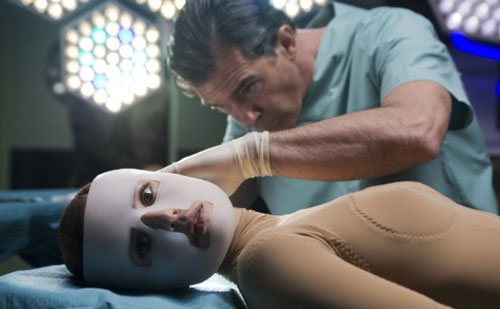
Rape, murder, suicide and twisted medical experiments are just the beginning. Even by the perverse standards of Pedro Almodóvar, The Skin I Live In is bizarre and disturbing. It’s made even more so that it is one of the most carefully controlled films ever made by Spain’s greatest living director.
The Skin I Live In is as elegantly composed as a Hitchcock thriller. By contrast with the voluptuous sensuousness and grimy earthiness of most of Almodóvar’s filmography, it is austere and restrained. José Luis Alcaine’s cinematography is frigid, but also full of startling imagery.
The garish shocks of colour that saturate most of Almodóvar’s films give way to a chilly, clinical palette; unusually for one of his films, it murmurs its lurid emotions and sensational happenings sotto voce.
The Skin I Live In is an update of the Frankenstein myth, this time with a brilliant Spanish plastic surgeon taking the part of the mad professor. Following the death of his wife in a fire, Dr Robert Ledgard (played by Antonio Banderas) becomes obsessed with a quest to create a synthetic human skin tough enough to withstand fire and insect bites.

A mysterious and beautiful young woman (Elena Anaya) — a bird in a gilded cage, afforded every luxury except freedom — is the subject of his experiments and obsessions. From the LCD screens he uses to watch her, he studies her as if she were a painting. That’s about as much as you should know about the film when you see it to maximise the impact of its plot twists.
The Skin I Live is itself a Frankenstein’s monster of a film, carefully stitched together from parts exhumed from melodrama, horror and psychological thriller. There’s a hint of the sexual obsession of Hitchcock’s Vertigo in here, a dash of body horror from David Cronenberg’s Dead Ringers, and more than a touch of the grotesque poetry of Georges Franju’s 1960 horror classic Eyes Without a Face.
It’s an exploration of Almodóvar’s favourite themes: gender identity, selfhood, genetic destiny, and family ties. The questions it asks about the nature of personal identity, gender relations and desire are profound and unsettling, though Almodóvar phrases them in a manner that is as witty as it is disquieting.
Banderas, a fixture in Almodóvar films in the early years of their careers, last worked with the director in the kinky Tie Me Up, Tie Me Down in 1990. Like Penelope Cruz, Banderas shines when he his working in his native tongue and excels under Almodóvar’s direction.
With his tailored suits, impassive features and slicked down, jet black hair, Banderas’s Ledgard seems at first glance to be a model of scientific detachment and medical professionalism. His eyes blaze with the insanity that his dispassionate face disguises so well.
The Skin I Live In trailer (via YouTube):
Under the manicured look, Ledgard is the most deranged cinematic doctor since the twin gynaecologists played by Jeremy Irons in Dead Ringers. He is a man utterly without scruples, driven by dark desires that must be quenched at any cost.
As Vera Cruz, Anaya cuts a tragic, lonely figure grasping for dignity and control. Marisa Paredes as the Igor to Banderas’s Frankenstein — a faithful housekeeper who is the only person who knows all the secrets in Ledgard’s house of horrors — is tortured but implacable.
Like many of Almodóvar’s films, The Skin I Live In walks a tightrope between trash and high culture, schlock and horror, sensuality and disgust, absurdity and profundity in a way that only a great and audacious artist would dare to. It entertains and amuses even as it confronts and provokes. — Lance Harris, TechCentral
- Subscribe to our free daily newsletter
- Follow us on Twitter or on Google+ or on Facebook
- Visit our sister website, SportsCentral (still in beta)




